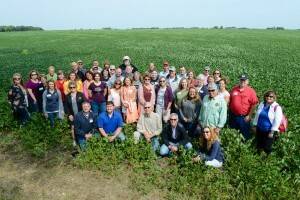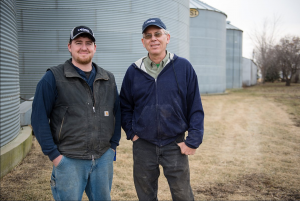
It’s amazing what comes to mind when you find yourself traveling mile after mile – for hours on end over the course of two days – through lush green hills in the southeastern Iowa countryside. The scenery is so picturesque that it’s a wonder I didn’t get off the bus and break into song. “The hills are alive with the sound of music…”
Instead my mind raced with lyrics to Frank Sinatra’s Love and Marriage… “Love and marriage. Go together like a horse and carriage… Dad was told by mother that you can’t have one without the other.”
While it may seem a bit corny, these lyrics reminded of the connection between food and farming. “Try, try, try to separate them, it’s an illusion. Try, try, try and you only come to this conclusion: You can’t have one without the other.”
We need farmers to raise everything from asparagus to zucchini, including field corn and soybeans to feed livestock. No one produces food more safely or efficiently than America, yet more than 70 percent of U.S. consumers know nothing or very little about farming or ranching.

Even more frightening is this statistic from an article published June 15, 2017, by The Washington Post: 7% of all American adults believe that chocolate milk comes from brown cows. If you do the math, there are 16.4 million misinformed people who drink milk but don’t know that chocolate milk is made from milk, cocoa and sugar. (Side bar: Chocolate milk is such a powerhouse of nutrition that many athletes drink a cold glass to provide the fluids, carbohydrates, proteins and electrolytes their bodies need to recover.)
One Department of Agriculture study, commissioned in the early 1990s, found that nearly 1 in 5 adults did not know that hamburgers are made from beef. And an increasing number of Americans who know where their food comes from wants to dictate how it’s produced.
Many of the environmental and stewardship practices being advocated for are already in place on farms across the country. Consumers participating last Friday and Saturday in Expedition Farm Country, a two-day bus tour hosted by the Iowa Food & Family Project and sponsored in part by Latham Hi‑Tech Seeds, got to see first-hand what conservation and environmental practices in place, including bioreactors that help prevent nitrogen from entering streams and waterways.

Conservation of the land and environmental stewardship is true passion for Mark and Michael Jackson. Michael, who raises crops and livestock as well as sells Latham® seed, is a sixth generation Iowa farmer. He’s the fifth generation to live in his family’s farmhouse. He farms with his father, Mark, who authors the monthly Farm Life Journal for the Iowa Food & Family Project.
In 2014, Mark Jackson was a featured speaker at a TED event in New York City. He says he’s motivated to leave the land better than he found it, so his grandchildren and future generations will have the opportunity to continue farming. Mark’s TED talk highlighted the technology used on his farm to aid in conservation, as well as to decrease pesticides while saving fuel costs.
Sustainability and responsibility were key messages shared by the farmers who hosted our tour. One Iowa dairy farmer explained that when he started farming regulations mandated many of his practices, while today consumers are making demands on how he treats cows and how his dairy processes milk. Unlike some of the other sectors of production agriculture, Dane Lang of Yarrabee Farms in Brooklyn, Iowa, says the practices he was asked to follow are best management practices that his family’s dairy already had in place.
Yarrabee Farms was founded in 1860, and the original farmhouse still stands and remains in use. This farming operation also is unique in that it still is managed by three generations: Maynard; Maynard’s son Craig and Craig’s wife, Mary; as well as two of Craig and Mary’s four children, Dane and Cade.
Another unique aspect of Yarrabee Farms it involves both beef and dairy herds. To stay in compliance with livestock regulations, cattle are kept on different farms. The milk cows are housed on the farm where Dane lives. Calves are taken to a nearby farm where someone else specializes in their care. Dairy heifers, as well as the beef cattle, are housed on the farm where Dane’s brother, Cade, lives. Cade’s wife, veterinarian Dr. Katie Lang, helps ensure all livestock stays healthy.
Consumers on the trip were reassured by the Langs, as well as by every livestock producer along the way including turkey producers, that they use antibiotics sparingly and responsibly. Withdrawal periods are required for antibiotics before any milk or meat animals leave the farm. In addition, all dairy and meat products are inspected to ensure the withdrawal periods are followed.
Tim Graber, a fourth generation turkey farmer from Wayland, says he employs antibiotics when needed. He also raises antibiotic-free turkeys, using natural remedies to nurse his birds back to health.
Let’s talk turkey for a minute… Iowa’s turkey growers are the number one supplier of turkey to Subway and Jimmy Johns. West Liberty Foods, a farmer-owned processing plant, also sources deli meats for Costco. The Graber’s turkeys are processed by West Liberty Foods. Tim also is a member of the local farmer-owned cooperative that focuses on producing high-quality feed for turkey growers.
New hatchlings arrive on the Graber farm weighing just one ounce. Expedition participants had the chance to hold 6-day poults, which weighed about 10 ounces. It takes about 18 weeks to get these toms to a market weight of 42 to 45 pounds.
The final farm visit of the Expedition was to Brenneman Pork in Washington County where animal care and research are top priority so “no pig ever has a bad day.”
Rob Brenneman’s pork operation began with nine pigs when he was just 9 years old. He and his wife, Char, started their operation in 1980. Today their fully-integrated operation, family-run operation includes a 29,000-sow farrow-to-finish operation. Their daughter-in-law Erin is one of the farrowing specialists. She actively shares “the beautiful world of farming” through SnapChat and Twitter as @sowmama.
In addition to meeting some of the world’s best farmers who also were the most gracious hosts, I’m confident that participants in Expedition Farm Country will feel more confident in the safety and quality of America’s food supply after meeting such caring farmers. I’m confident these participants now have a better understanding of how food products get from the farm gate to the dinner plate as each farm stop featured some of the area’s best foods: Subway sandwiches; Stone Wall Brick Oven Pizza and Wooden Wheel Winery; as well as koalches and ice cream sandwiches from Kalona, which is the largest Amish settlement west of the Mississippi River.
You can get a taste of farm-raised goodness with Quick & Easy Apple, Cheddar and Turkey Bacon Omelets. The recipe was printed in the “Cooking with Turkey” cookbook that participants on the 2017 Expedition Farm Country tour received, compliments of the Iowa Turkey Federation.
Also check out the Federation’s website for tailgating ideas, such as Breakfast Deviled Eggs, to main dishes like Crock Pot Cordon Bleu Turkey. (Crock Pot cooking makes it easier to eat well during the busy harvest season IMO. Did you know we have a whole section of Slow Cooker recipes on TheFieldPosition.com)
Quick & Easy Apple, Cheddar and Turkey Bacon Omelet
Ingredients
Ingredients:
2 eggs
2 tablespoons water
Salt and pepper to taste
1 teaspoon butter or vegetable oil
¼ cup apple pie filling
¼ cup (1 ounce) shredded sharp cheddar cheese
2 tablespoons chopped pecans
2 tablespoons chopped turkey bacon
1 tablespoon real maple syrup
1 tablespoon chopped pecans
Directions
Directions:
- Wash your hands thoroughly.
- Prepare all of the ingredients, including beaten eggs, prior to cooking.
- Beat together eggs, water, salt and pepper.
- In a 10-inch non-stick omelet pan over medium high heat, heat butter until just hot enough to size a drop of water. Pour in egg mixture. Mixture should set immediately around the edges.
- With an inverted pancake turner, push cooked portions from the edges of the pan toward the center so uncooked portions can spoil onto the hot pan surface. (Dig a hole and fill it!) Tilt the pan as necessary, keeping the bottom covered with egg.
- When the top is thickened and no visible liquid egg remains, fill one half of omelet with pie filling, cheese, 2 tablespoons pecans and bacon.* (Put filling on the left side if you’re right handed.) With pancake turner, fold omelet in half.
- Drizzle maple syrup over omelet Place under a broiler for about 30 second to caramelize the syrup. Garnish with one tablespoon of pecans prior to serving.
If you prefer to make a casserole instead of individual omelets, give this recipe for Bacon, Ham & Cheddar Omelet Bake a try! It’s on my menu for a baby shower that I’m hosting in early September.
